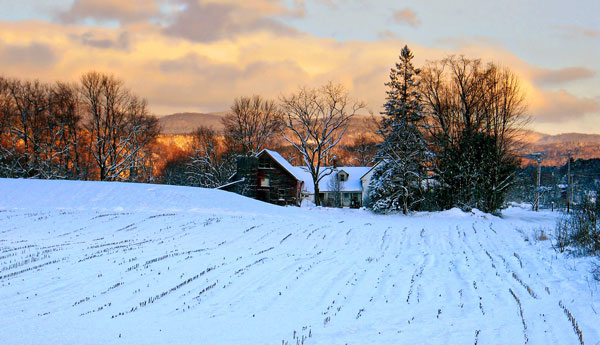
Chances are, if your homestead sits anywhere north of Texas this year, you have seen a fresh blanket of snow or two coat your land. If you live near where I do, that blanket didn’t just fall, but has lasted for several weeks now (and counting). We all love the fluffy white stuff for our favorite wintertime traditions, such as snowman making, sledding and snowball fights, but how does your land feel about snowfall? read on for some fun facts about snow’s effects on your land, crops and overall yield.
Snow as a Hydration Solution
If you’ve ever spoken to a farmer or gardener, you’ll likely know that all rainfall is not equal, despite the number of inches it may produce. Several inches of rain that falls in an hour is far less beneficial than the same amount of water coming down over several, as that torrential downpour will mostly wash off the land–potentially even causing flash floods–instead of having the time to soak in and moisturize the soil. With snow, that latter tendency is exacerbated, leading to even more beneficial effect. Slow melting snow sitting atop a field will release moisture into the soil as it melts ever so slowly, creating incredibly fertile dirt.
How much water does snow actually have in it, however? The general rule of thumb is that 10 inches of snow holds about an inch of water, but the reality is a little more complex. How much water is retained in snow hinges largely on surface temperature when the snow is falling. The above is true for a ground that is just at or under freezing (~30-32 degrees Fahrenheit), but if the temperature is higher, the snow becomes wetter, making the ration closer to 8:1. Of course, if the ground (or likely the entire atmosphere) is much colder–say 20 degrees–the opposite occurs, and the ratio jumps to about 30:1 as the snow dries out. On the plus side, this makes it much lighter and easy to shovel!
While the majority of this benefit will be reaped in the springtime, when crops are gown and sown, cattle can find the snow useful while the weather is still grim. Unlike humans, who can become dehydrated by eating snow, as our organs have to work too hard to warm it, cattle can fulfill a significant amount of their hydration requirements with snow, though care should be used when first introducing them to the practice. Observe that they are actually taking advantage of the fluffy water, otherwise you could be parching the poor things, who have not yet figured out that snow=water. Snow should also not be too compacted, and certainly not icy for this to work.
Snow as a Sweater
Benefits go beyond simple hydration, too. While it may seem a tad counterintuitive, snow is an excellent insulator thanks to the air trapped inside of it. A mere two to four inches of snow can raise soil temperatures about five degrees. If the temperature is hovering right around freezing, this can be a significant boon, keeping the soil just warm enough to stay thawed.
For crops that are overwintered, like wheat, this insulation is a necessary component to keeping the crop alive throughout the cold winter months. Wheat needs at least three inches of snow for insulation in colder climes, with more–of course–being better.
Snow as Fertilizer
Finally, snow doesn’t just contribute to a soil’s H2O. Snowflakes trap dissolved organic nitrogen, ammonium and nitrate while plummeting through the atmosphere. Together with rain, it can provide up to 22 pounds of nitrogen per acre of soil, per year. Sure, this can’t totally replace a good fertilizer, but it sure can help it along.
Snow Retention
So how does one go about keeping snow on your land, to better reap all these benefits. It turns out, there are quite a few methods to do so, some more labor intensive than others. If you live up in the great white north, where regular snowfall can be counted on, chances are you are already using one or more of the more serious options. Forest and shrub belts, buffer zones, contour farming, snow fences, snow nets and plowed snow ridges are just a few of these.
If you live a little further south, however, some of the easier methods may still yield enough retention of the occasional snow to be helpful. My personal favorite is allowing the stalks of crops to protrude through a field all winter. These do not have to be at their full height–they can be cut down as far as you wish–their main purpose is simply to trap snow around them instead of allowing it to blow off. A cover crop like rye can also help keep snow in place, though it will require waiting a bit to plant after mowing it down in the spring, as its decomposition will occupy the nutrients in your soil for a bit (primarily the nitrogen, I believe).
So this winter, whether you love or hate the white stuff, give some thanks when you see it coating your fields. While you may not appreciate it on your walk or windshield, it is an excellent way to keep your ground healthy and hydrated until growing season comes around again.
A humble homesteader based in an undisclosed location, Lars Drecker splits his time between tending his little slice of self-sustaining heaven, and bothering his neighbors to do his work for him. This is mainly the fault of a debilitating predilection for fishing, hunting, camping and all other things outdoors. When not engaged in any of the above activities, you can normally find him broken down on the side of the road, in some piece of junk he just “fixed-up.”
